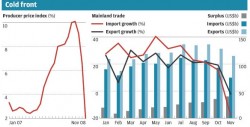Why are “economists” surprised? Of course things are getting worse, also in China that has more advantages to face the turmoil. But if it does not change some of its habits, we could face a stormy 2009. See here what those “experts” are stunned by – chart from 11 December, SCMP. And they all forgot the negative impact of the Olympics on the order books.
Comments from some well-known dissidents (edited for obvious reasons):
China must make its political reform match its outstanding economic achievements and root out the corruption and collusion between officials and entrepreneurs throughout the country.
But it’s impossible for the Party to transfer its power to the people willingly. More massive unrest will take place soon.
Corruption, social unrest and other injustices on the mainland have been aggravated by the lack of checks and balances because of the halt to political reform.
All the social elites and media have refused to take social responsibility and have kept silent about all the injustices. They just care about whether the government will offer them opportunities for career development.
Unfortunately, a lot of that is true. Social unrest is increasing, nothing strange in view of the recession. As usual, ordinary workers are the immediate victims and “worker unions” are nowhere to be seen when needed.
Hundreds of striking migrant workers picketed an electronics factory in Shanghai for a third day on 10 December in a feud stemming from allegations of layoffs and unpaid bonuses.
The workers claim Shanghai Yixin Industry owes them months of unpaid benefits for working in high temperatures during the summer and overtime for working night shifts.
“The company’s gangsters attacked and beat us using pickaxes,” said one protester, who showed a photograph of the alleged weapons on his mobile phone. “The police arrested five people yesterday and one person this morning. They beat up more than 10 people on Monday night, and some are still in hospital.”
Several protesters showed cuts and bruises on their arms, shoulders and faces. All reported by SCMP.
As usual, factory representatives, police and local authorities tell a different story. All too typical, including the use of “gangsters” (Henan Province has lots of them, see Tom’s story).
Those are the challenges. If authorities do not address the unlawful situations, do not protect workers’ rights, do not root out corruption at local official levels, the comments of the dissidents will prove to be more than true.
But for China, this is not all that new and shocking as some might think. See here what our friend Jasper Becker wrote:
Layoffs trigger rise in protests
China has been hit by one of the worst outbreaks of industrial unrest since the reform policy started in 1979.
Chinese sources said the number of protests had been growing all year as more than half the state-run industries had been unable to sell their products or pay wages and pensions.
In the worst-off industrial cities in Heilongjiang province, such as Shuangyashan, Jixi, Jiamusi and Mudanjiang, up to 80 per cent of the workforce has been laid off. Many were surviving on handouts of as little as 70 yuan a month.
Even in cities like Tianjin, Shanghai and Beijing, workers and pensioners had staged sit-ins in factories or in front of local party headquarters demanding unpaid wages and payments, they said.
‘There were strikes and sit-ins taking place in all the cities I visited, often with the tacit support of local cadres,’ said Trini Leung, a researcher from the University of Hong Kong who spent three months traveling through Manchuria to study the labor crisis.
On October 22, hundreds of unpaid miners in Shuangyashan staged a sit-in in front of the local party headquarters, watched by police, to press their demands. Sources said that before this year’s Spring Festival 40,000 people took to the streets.
Many of the miners, made redundant by the collapse of the provincial coal mining industry, were reported to be unable to afford winter clothing, while in orphanages staff were unable to make do with an allowance of 40 yuan per child. In Shenyang, the capital of Liaoning province, 350,000 workers were reported to have been laid off, many without pay.
In Tianjin, which has attracted far more outside investment, state-run industries had been shedding workers all year. As output plunged, many enterprises, including the famed Flying Pigeon Bicycle Factory, had halted production for a part of each month.
The unemployment rate in Tianjin’s industrial workforce is about 40 per cent.
Sources said that the Flying Pigeon factory had dismissed 7,000 of its 20,000 workers, while another factory producing glass fibre had released half its 3,000 workers.
In cities across the country as many as 50 million workers have been laid off or are underemployed.
In Beijing, many factory employees work only a few days a month and no longer receive the all-important production bonuses.
Date of the above SCMP article: 28 November 1996. History repeats itself. China did not burn down. Somehow, inspires optimism.
